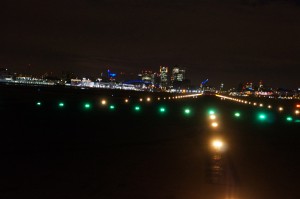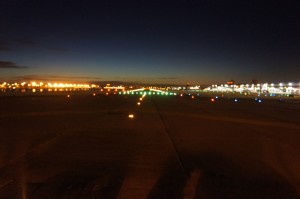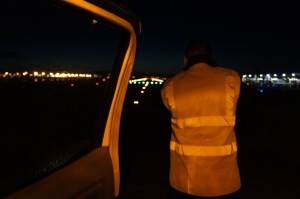It was still dark as Harish, from the web site team and who was my escort for the morning, kitted me out in a very fetching Hi-Viz jacket, and obtained the pass I would need to let me airside – escorted of course. The helpful man at the Information desk exchanged my passport for my pass and I was set to go.
The terminal was quiet, with the self-service check-in machines waiting in line for passengers to start to arrive.
Through the secret door I went to find the staff security channel. Quite inadvertently I left both my iPad and liquids in my bag as I sent it through the X-ray. With charm and only a little bit of a raised eyebrow, the staff checked the bag, retrieved the items and scanned it again. You might have thought I should know better after my travels, but somehow this friendly, chatty security seemed so different to my normal experiences. Clearly they knew all the staff coming through, who had to swipe their cards and enter their finger print before proceeding through the arch.
Once airside my first port of call was the Ops Team. These are the guys responsible for the airport between closure and opening, and who make decisions which can impact the arrival of your plane – ‘How wet is the runway – Dry, Damp or Wet?’ a question which can decide what sort of plane is allowed to land and take off.
The first job was to check the lights – ‘Ok, that should only take 10 minutes’ I naively thought – 7,000 lights later……well you don’t actually have to hand check everyone, but the Ops Team Leader took me out in the vehicle they use to inspect the runway. Still dark we started from one end of the runway, drove its full length checking all the lights on the taxiways, exits, and even the building and ramp lighting. The light on stand 22 was out, he noted.
This gave me a unique chance to stand on the 1,500 m long runway – and look down the centre line. The green lights in the picture above mark the runway threshold, after which it is safe for the pilots to land. Further down, you can see yellow and red lights – warning the pilot he is getting to the other end of the runway, and that stopping ought to be his next step.
The number and range of lights is impressive. The Ops Team Controller had to radio to the office to have each set illuminated when they needed to be checked. After years of experience he knew not only where every light should be but whether its failure would close the airport, and which ones had been reported already. The job must come with it’s fair share of worries, after all a lamp out on a foggy day could have dire consequences. Although many of the lamps have self-reporting sensors in them to record if they have failed, the daily visual check is still the best way to be certain all is well. Separate members of the team check the approach lights at both ends of the runway.
Replacement of blown lamps occurs during the airport closure period for noise reasons – between Saturday lunchtime and Sunday lunchtime, when no flights come or go.
Around 6.30am the big call is made – the Ops Teams formally hand over the runway to Air Traffic Control, safe in the knowledge that planes can land with everything working properly.
During the visit I finally learned which buildings require red flashing lights and which do not. There is an imaginary area surrounding the airport which is protected from development in order to protect aircraft. Where this is punctured by a building – it needs red lights.
Back in the office the team has a model of an A380 and I wondered if this airport might ever expand enough to accept the whale of the skies, if so, I know that the team I met would be ready for it – with every lamp lit and the runway safe for passengers.
Come back tomorrow for the next installment – Part 2 – Ramp Control – a tale of skis and teams







“drove it’s full length checking all…” and other examples: so you’re not a professional writer it seems…?
@Penly – indeed not, but have fixed that one and some others I saw! Thanks for the heads up.